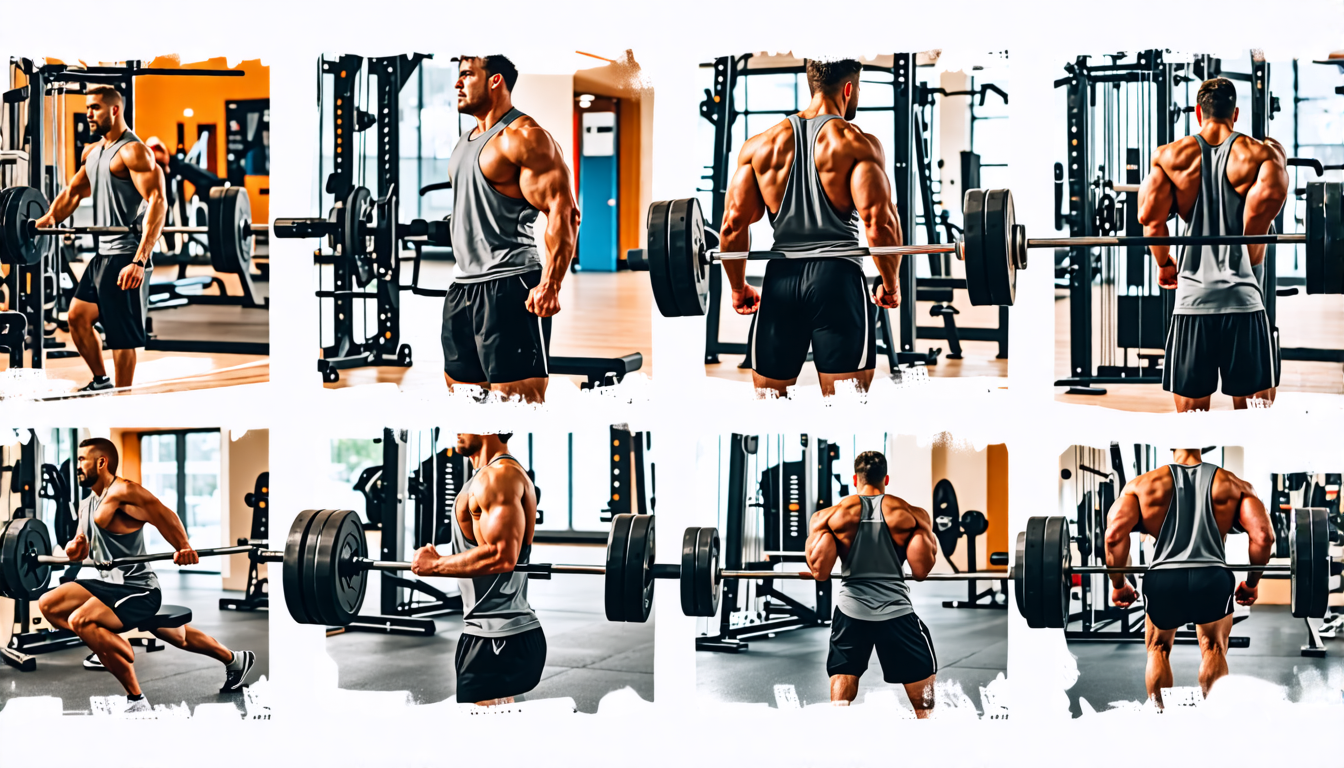Incorporating a home fitness bar into your routine can significantly transform the way you approach strength training, particularly when focusing on improving grip strength. As many fitness enthusiasts understand, grip strength is not just about having a firm handshake; it’s a critical component of overall fitness that enhances your ability to perform a wide range of exercises and daily activities. This introduction to the best exercises for enhancing grip strength with a fitness bar will guide you through effective movements and routines that are easy to perform at home, requiring minimal equipment yet delivering maximum results. From dead hangs and farmer’s walks to reverse curls, these exercises target the muscles in your forearm and hand, promoting increased grip endurance and power. You’ll discover tailored variations for different fitness levels to ensure everyone can benefit from the comfort of their home gym. Emphasizing the importance of proper form, not only will this article help you improve your grip, but it will also support your overall safety and injury prevention. Additionally, you’ll learn about the multifaceted benefits of stronger grip strength, like boosting your performance in various sports, enhancing your lifting capacity, and reducing injury risks. By integrating gradual weight increases, consistency, and grip-specific workouts into your routine, you can effectively enhance your grip strength over time. Moreover, practical tips such as integrating rest periods and incorporating stretching exercises will help maintain optimal grip health. Embrace the power of a fitness bar at home and take the first step towards a stronger, more capable grip today.
Effective Grip-Enhancing Exercises with a Fitness Bar
When it comes to building grip strength, the fitness bar is a versatile piece of equipment that can help you achieve significant results. Whether you’re using this in a professional gym setting or as part of your home fitness bar setup, incorporating key exercises such as dead hangs, farmer’s walks, and reverse curls into your routine can specifically target and improve the muscles in your forearms and hands. This section will guide you through these exercises, including variations to accommodate different fitness levels and tips on maintaining proper form to prevent injuries.
Dead Hangs
The dead hang is a simple yet effective exercise to improve grip strength. To perform this exercise using a fitness pull-up bar, start by gripping the bar with both hands at shoulder-width apart. Ensure your grip is firm but not overly tight to avoid strain. Allow your body to hang freely, engaging your core, shoulders, and forearms to maintain stability. For beginners, aim to hang for 15-30 seconds, gradually increasing the duration as your grip strength improves. An advanced variation includes weighted dead hangs, where you can add extra weight using a weight belt, further challenging your muscles. Proper form is crucial: keep your arms straight, shoulders down, and avoid swinging to prevent injuries.
Farmer’s Walks
Farmer’s walks are another excellent exercise to include in your home fitness bar routine to build grip strength. While traditionally done with dumbbells or kettlebells, a barbell version can be just as effective. Secure a barbell plate on each side of the bar, ensuring the weight is balanced and manageable. Stand with feet shoulder-width apart, hold the bar firmly, and walk a set distance or for a set time (e.g., 30-60 seconds). This exercise not only works on grip strength but also engages your entire body, including your core and legs. To increase difficulty, gradually increase the weight as your grip strength progresses. As always, maintain a straight back, engaged core, and controlled steps to prevent any injuries.
Reverse Curls
Reverse curls specifically target the muscles in the forearm and the brachioradialis muscle, crucial for grip strength. Using a fitness bar, start with a lighter weight for beginners and increase as you advance. Stand upright, holding the bar with an overhand grip and arms fully extended. Curl the bar towards your shoulders, keeping elbows close to your body. Lower the bar slowly to maximize tension on the muscles. Performing 3 sets of 8-12 repetitions is a good starting point, adjusting as your strength increases. Variations include the use of an EZ bar for a more comfortable wrist position, which can be particularly helpful for those new to the exercise.
Importance of Proper Form
Emphasizing the importance of proper form can’t be overstated when it comes to exercises designed to improve grip strength using a fitness bar. Improper form not only reduces the effectiveness of the exercises but also significantly increases the risk of injury. Always ensure your wrists are aligned with your arms and avoid excessive strain. Gradually increasing the intensity and weight will yield better results than rushing through exercises with incorrect technique. Additionally, incorporating rest periods and flexibility exercises into your routine can help prevent overuse injuries and facilitates better recovery for your grip muscles.
By consistently integrating these exercises into your fitness regimen, especially within a home fitness bar context, you harness the power to vastly improve your grip strength. This foundational strength will carry over to various other exercises and daily activities, enhancing overall performance and efficiency. Remember to listen to your body, progress at a safe pace, and prioritize form over sheer weight or duration.

Benefits of Improved Grip Strength and Tips for Progression
Improving grip strength using a fitness bar not only enhances your ability in various exercises and activities but also brings a wealth of other benefits that directly translate into everyday life and sports performance. A strong grip is crucial for athletes, fitness enthusiasts, and individuals looking to improve their physical capabilities and safety during exercise routines.
One of the primary benefits of enhanced grip strength is the increased lifting capacity. Whether you are performing deadlifts, pull-ups, or rows, a firm grip on the fitness bar ensures that your muscles can exert maximum force without your hands giving way before the muscles being targeted get fully worked. With exercises like dead hangs or farmer’s walks using a fitness bar, you can effectively train your grip to hold on longer and more powerfully, thereby allowing you to lift heavier weights over time. This progress not only boosts your self-esteem but also significantly enhances your overall muscular strength and endurance.
Another significant advantage of building grip strength is the reduced risk of injury. A strong grip can ensure better control over weights and reduce the chances of having weights slip from your hands, which can lead to accidents and injuries. Engaging in regular grip-strengthening exercises with a fitness bar helps to fortify the muscles and tendons in your hands and forearms, making them more resilient to strain and stress during exercise sessions and daily tasks.
Moreover, improved grip strength contributes to enhanced performance in sports that require effective hand dexterity and strength, such as rock climbing, tennis, and golf. Athletes in these domains can benefit from incorporating grip-strengthening workouts into their routines, giving them a competitive edge by improving endurance and precision in their sporting activities.
Progressing in grip strength is essential to continue reaping these benefits. Start by adding grip-specific exercises to your home fitness bar routine, tailoring them to suit your current fitness level. Begin with manageable weights and gradually increase the difficulty by either adding more weight or prolonging the duration of hold in exercises such as dead hangs. Consistency is key; incorporate these grip-enhancing exercises two to three times weekly alongside your regular fitness regimen to see tangible improvements over time.
Additionally, it’s important to track your progress to keep motivated and continuously challenge your grip strength capabilities. Consider using a logbook or a fitness tracking app to record repetitions, weights, and durations. Setting specific goals, like increasing your farmer’s walk distance or extending your dead hang time, can keep you focused and driven.
Awareness of technique is crucial in preventing injury while progressing in grip strength exercises. Focusing on proper form and mindful execution ensures that you are engaging the correct muscles without putting undue stress on your joints or tendons. With exercises like reverse curls using a fitness bar, pay attention to maintaining a straight wrist position and perform controlled movements to maximize benefit and minimize risk.
To maintain overall grip health and avoid issues such as overuse injuries, incorporate regular stretching of the forearm and hand muscles. Stretching helps to relieve tension, improve flexibility, and prevent stiffness in your grip, contributing to overall performance and discomfort reduction. Simple stretches, like wrist flexor and extensor stretches, should be included in both warm-up and cool-down phases of your workouts.
Finally, respecting rest and recovery is as important as the workout itself. Allow your grip muscles time to recuperate to ensure that continued efforts in strengthening them are effective. Rest days help in repairing micro-tears and preventing fatigue, thereby enhancing the recovery process and preparing your muscles for the next session.
In conclusion, enhancing grip strength is a crucial component of overall fitness, and the use of a fitness bar can significantly contribute to this goal. By incorporating exercises like dead hangs, farmer’s walks, and reverse curls, individuals can effectively target and strengthen the muscles of the forearm and hand. These exercises not only improve grip strength but also offer variations that cater to different fitness levels, ensuring accessibility and safety for all users. Proper form is critical to prevent injury, emphasizing the importance of technique over sheer strength.
The benefits of improved grip strength extend far beyond just the ability to hold onto a bar longer. Enhanced grip facilitates better performance in various sports, like rock climbing or tennis, where hand strength is pivotal. It also increases one’s lifting capacity in weight-bearing exercises, allowing for more balanced and effective workouts. Moreover, a stronger grip can contribute to reducing the risk of injuries, particularly strains associated with poor handling or improper form during exercises.
To ensure continuous improvement in grip strength, it is essential to follow a progressive approach. Gradually increase weights or difficulty levels, practice consistently, and integrate grip-specific workouts into your regular fitness routine. Additionally, maintaining grip health should not be overlooked. Including stretching exercises and allowing adequate rest periods can prevent burnout and overstrain, keeping your grip strong and resilient.
Incorporating a home fitness bar setup is a practical way to consistently work on these exercises. It allows for convenience and the ability to practice grip-strengthening exercises regularly without the need to visit a gym. Whether you’re hanging from a pull-up bar or lifting a weighted barbell, a home fitness bar can be an essential tool in building and maintaining robust grip strength, ultimately enhancing your overall home fitness regime.

